Our trip from Cusco, to Lake Titicaca and eventually La Paz, Bolivia is delayed by a day. We both have come down with some sort of “intestinal infection”. It must be food borne since we both are ill!
Our abode in Cusco, Hostal El Triunfo, has been excellent. Overall they have worked to meet all of our requests and are very kind. As soon as we tell our host we are sick she notifies a local Clinic, Clínica Peruano Suizo.
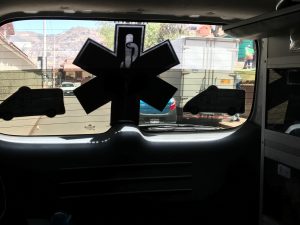
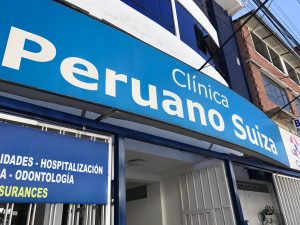 In less than ten minutes, two providers, perhaps a physician and an EMT type arrive. After a brief exam in our room, they drive us to the clinic in the ambulance. Nice service, lol.
In less than ten minutes, two providers, perhaps a physician and an EMT type arrive. After a brief exam in our room, they drive us to the clinic in the ambulance. Nice service, lol.
Two hours later we have a diagnosis of a parasito and a prescription to eliminate it! We return to the hotel and basically spend the rest of the day and night sleeping.
Tuesday
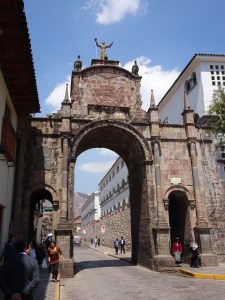
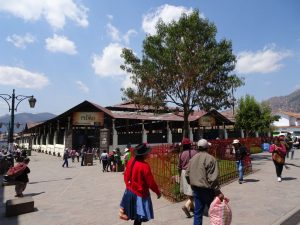 Tuesday morning is a new day and we are feeling like we have been “put through the ringer”, but a little bit better. We check out of our room at 9 am and spend the day primarily at Starbucks. We take a break from Starbucks for lunch, dinner and a trip to the San Pedro Market, the local market of Cusco.
Tuesday morning is a new day and we are feeling like we have been “put through the ringer”, but a little bit better. We check out of our room at 9 am and spend the day primarily at Starbucks. We take a break from Starbucks for lunch, dinner and a trip to the San Pedro Market, the local market of Cusco.
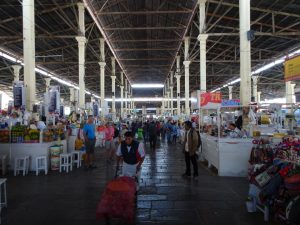
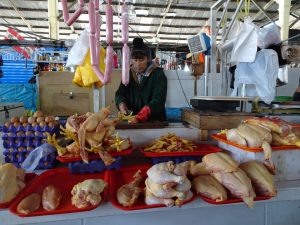 The market has a few souvenir type items but looks to cater mostly to locals and their everyday needs for food and clothing. It is always interesting to me seeing where and how locals buy most of their food products.
The market has a few souvenir type items but looks to cater mostly to locals and their everyday needs for food and clothing. It is always interesting to me seeing where and how locals buy most of their food products.
Our transport from Cusco is later in the evening, at 10:15pm. Right on time, we settle into our full recline seats with our blankets and are on our Peru-Bolivia Hop bus bound for the overnight trip to Puno, Peru!
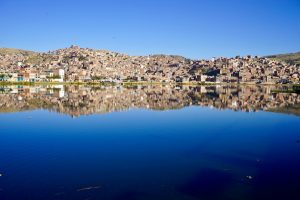 Puno is a city in southern Peru on the shores of the massive Lake Titicaca. We sleep most of the bus trip and arrive in Puño around 5:00 am.
Puno is a city in southern Peru on the shores of the massive Lake Titicaca. We sleep most of the bus trip and arrive in Puño around 5:00 am.
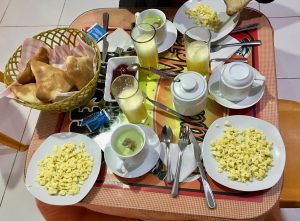 Breakfast at a local cafe is arranged with fresh bread, eggs, tea and coffee. I try everything and the stomach seems to withstand!
Breakfast at a local cafe is arranged with fresh bread, eggs, tea and coffee. I try everything and the stomach seems to withstand!
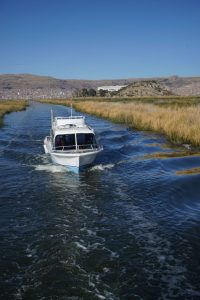
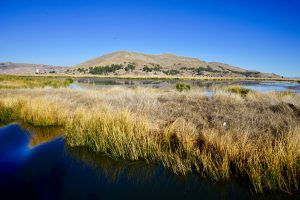 We finish breakfast and after a short walk to the waterfront it is 6:25 am and we are aboard the Victor Class boat. We set sail on Lake Titicaca, the highest navigable freshwater lake in the world at 12,507 ft. It is over 3,232 square miles and nearly 1,000 ft deep at its deepest point. It is 118 miles at its longest point it and 51 miles at its widest.
We finish breakfast and after a short walk to the waterfront it is 6:25 am and we are aboard the Victor Class boat. We set sail on Lake Titicaca, the highest navigable freshwater lake in the world at 12,507 ft. It is over 3,232 square miles and nearly 1,000 ft deep at its deepest point. It is 118 miles at its longest point it and 51 miles at its widest.
The lake is divided between two countries with part lying in Peru and Bolivia. The water is fed fresh from the mountains, with 27 rivers feeding the lake and only one river flowing out, the Desaguadero River. It is here that Lake Titicaca empties into, yes, Lake Poopó.
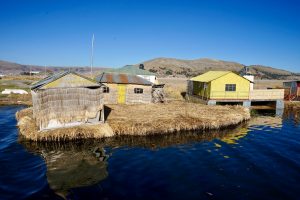 The major attraction here in Puno are floating islands, Islas Uros, home to some of the indigenous Uros people of Peru and Bolivia. The islands are constructed of the totora reeds that are plentiful in the lake. The islands must be reinforced at least annually because the reeds eventually rot. The islands have a “spongy” feel when you walk on them. The reeds are also used to construct their homes, boats and arts and craft.
The major attraction here in Puno are floating islands, Islas Uros, home to some of the indigenous Uros people of Peru and Bolivia. The islands are constructed of the totora reeds that are plentiful in the lake. The islands must be reinforced at least annually because the reeds eventually rot. The islands have a “spongy” feel when you walk on them. The reeds are also used to construct their homes, boats and arts and craft.
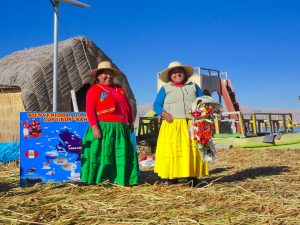 We spend about an hour at one of the floating villages on a small island and hear a bit about how they live. We meet some of the locals, see their homes and learn about the engineering that goes into maintaining their island and homes during rainy and dry seasons.
We spend about an hour at one of the floating villages on a small island and hear a bit about how they live. We meet some of the locals, see their homes and learn about the engineering that goes into maintaining their island and homes during rainy and dry seasons.
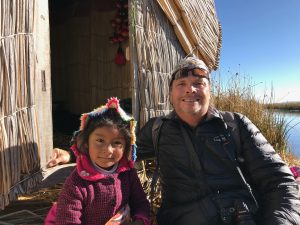 The young girls are very cute, friendly and speak Spanish as well as their local language.
The young girls are very cute, friendly and speak Spanish as well as their local language.
Around 9 am we are back on the bus for about a two hour trip to the Peru – Bolivia border. The route follows the lake on one side, farms and low arid hills on the other. There are a fair amount of livestock, sheep, llama and cattle. It seems mostly women tending to the farms. We also pass along the lake with a spectacular view of the snow covered Andes mountain range across Lake Titicaca.
Once we reach the border, we gather all our belongings as we will be changing buses once on the Bolivian side. We obtained our visas in the US before leaving as well as being vaccinated for yellow fever. It wasn’t exactly clear whether we needed the vaccination for entry, however, since we did a trip to Peruvian Amazon Rainforest, we wanted to make sure. Our itinerary was required for Bolivia which indicated our visit to the jungle.
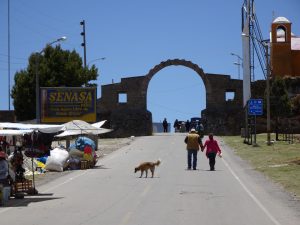 The border crossing is relatively uneventful. We stamp out of Peru, walk through the border gate into Bolivia. It is a surreal feeling walking across a border into another country. Once across, we line up outside a small building –Bolivian Immigration. We clear without a problem and on our way to Copacabana!
The border crossing is relatively uneventful. We stamp out of Peru, walk through the border gate into Bolivia. It is a surreal feeling walking across a border into another country. Once across, we line up outside a small building –Bolivian Immigration. We clear without a problem and on our way to Copacabana!
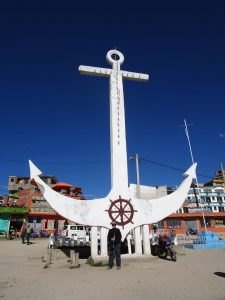
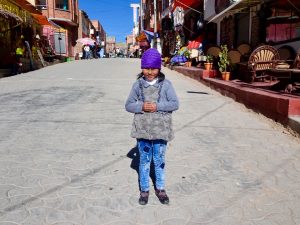 We arrive in Copacabana in less than 30 minutes after the border crossing. The hilly town sits on Lake Titicaca. More hills and of course high altitude! Two factors that do not mix well!
We arrive in Copacabana in less than 30 minutes after the border crossing. The hilly town sits on Lake Titicaca. More hills and of course high altitude! Two factors that do not mix well!
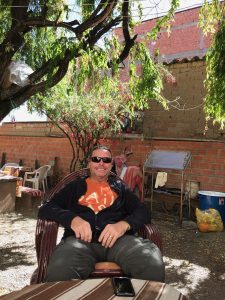 We check into our hotel, freshen up a bit after basically 14 hours of traveling and we are off to explore the town. We set a leisurely pace and find a restaurant called Bambu. It is in a nice garden-like setting for a late lunch. The weather is perfect, pure sunshine, nice temps. We enjoy some chicken skewers and a vegetable rice stirfry.
We check into our hotel, freshen up a bit after basically 14 hours of traveling and we are off to explore the town. We set a leisurely pace and find a restaurant called Bambu. It is in a nice garden-like setting for a late lunch. The weather is perfect, pure sunshine, nice temps. We enjoy some chicken skewers and a vegetable rice stirfry.
After lunch we stroll down to the Titicaca lakefront where we will launch our day trip by boat to Isla del Sol tomorrow. We return to the hotel for a shower and a relaxing evening…minus the music. There has been live music going on all day and into the wee hours…maybe a full moon party? Tracey’s earplugs work for her, lol. If we were not still being impacted by our stomach bug and acclimating to the altitude we may have joined them!
Thursday
It looks like a “bright, bright, bright, sunshiny day” for our trip to Isla del Sol, an island rooted in Incan history. The Incas believed that Isla del Sol was the birthplace of the Sun God.
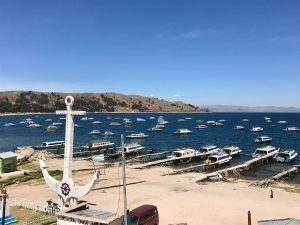 We meet some wonderful Kiwis and hang out with them for lunch and share travel stories. The quinoa soup and tortilla pollo with guacamole is pretty good. The view over the Copacabana harbor makes it even better.
We meet some wonderful Kiwis and hang out with them for lunch and share travel stories. The quinoa soup and tortilla pollo with guacamole is pretty good. The view over the Copacabana harbor makes it even better.
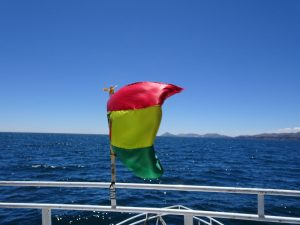
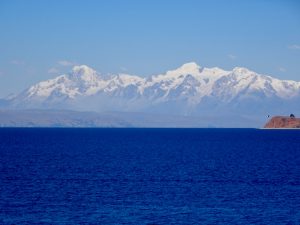 The boat trip over to Isla del Sol is a nice trip and only about an hour. I stay up top on the small boat and it is a bit windy. There are a few of us up here, “hunkered” down! The snow covered mountain range in the distance across this massive lake is stunning, looking like a painting.
The boat trip over to Isla del Sol is a nice trip and only about an hour. I stay up top on the small boat and it is a bit windy. There are a few of us up here, “hunkered” down! The snow covered mountain range in the distance across this massive lake is stunning, looking like a painting.
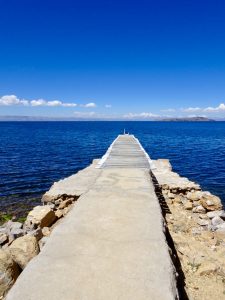
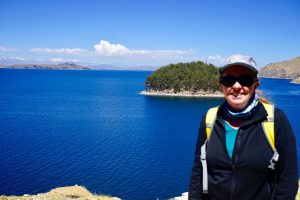 The boat docks briefly and we disembark. We have an hour to hike up the hillside before we catch the boat docked at a different area of the island. The views of the mountains and lake are magnificent from this vantage point.
The boat docks briefly and we disembark. We have an hour to hike up the hillside before we catch the boat docked at a different area of the island. The views of the mountains and lake are magnificent from this vantage point.
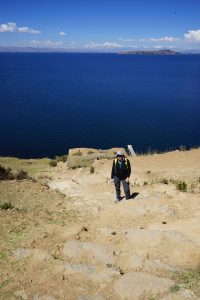
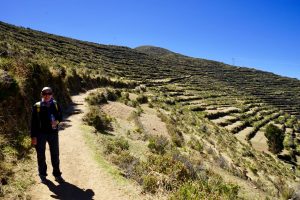 The hike is a bit strenuous being above 12,000 ft.
The hike is a bit strenuous being above 12,000 ft.
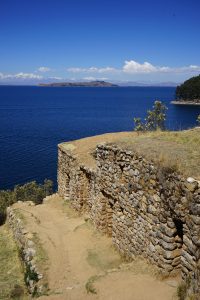
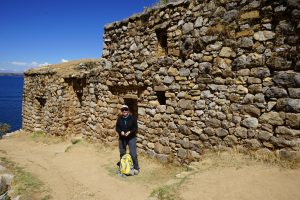 Isla del Sol is home to around 800 families that primarily farm and fish. There is of course tourism and a couple places to stay. There are no cars or paved roads on the island. As we hike, we pass by some ruins of which there are over 80 on the island. Most of them date to the Inca period, the 15th century. There is evidence that people lived on the island as far back as the third millennium BC.
Isla del Sol is home to around 800 families that primarily farm and fish. There is of course tourism and a couple places to stay. There are no cars or paved roads on the island. As we hike, we pass by some ruins of which there are over 80 on the island. Most of them date to the Inca period, the 15th century. There is evidence that people lived on the island as far back as the third millennium BC.
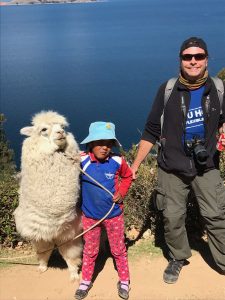 We run across a “girl and her llama”. She is set up for business! No dinero, no photo! And I take two so she tells me and wants more. “You took two!”, she says emphatically. I offer a five US, but she wants Bolivian currency. I end up giving her Bolivian, but it is less than if she had taken the USD. She is a good salesperson but needs to learn currently exchange, lol.
We run across a “girl and her llama”. She is set up for business! No dinero, no photo! And I take two so she tells me and wants more. “You took two!”, she says emphatically. I offer a five US, but she wants Bolivian currency. I end up giving her Bolivian, but it is less than if she had taken the USD. She is a good salesperson but needs to learn currently exchange, lol.
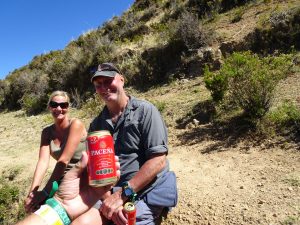
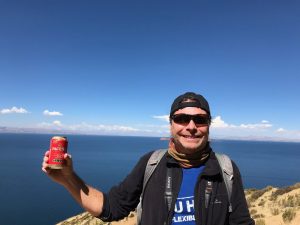 We meet some friendly folks from Sweden who share their local beer with me. It is always good to take a six pack with you when hiking, lol. Not bad tasting!
We meet some friendly folks from Sweden who share their local beer with me. It is always good to take a six pack with you when hiking, lol. Not bad tasting!
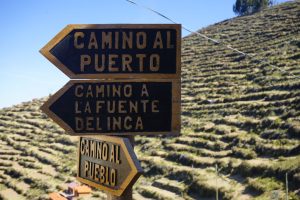
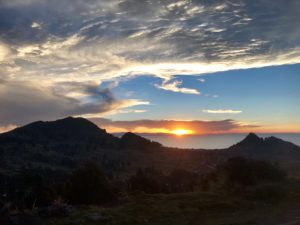 We return to Copacabana and board our bus to La Paz. The bus ride, at sunset, travels through some amazing countryside of mountains alongside the lake.
We return to Copacabana and board our bus to La Paz. The bus ride, at sunset, travels through some amazing countryside of mountains alongside the lake.
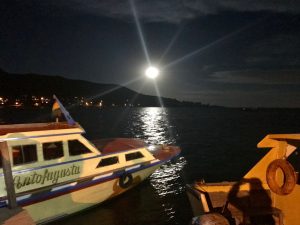 After the sun set, about an hour into the ride, we have a river to cross. What makes this interesting is that there is no bridge! It is a wide river crossing, so the buses are loaded on a “barge”. We disembark first and are put on a small boat, ferried across the river. Very interesting!
After the sun set, about an hour into the ride, we have a river to cross. What makes this interesting is that there is no bridge! It is a wide river crossing, so the buses are loaded on a “barge”. We disembark first and are put on a small boat, ferried across the river. Very interesting!
 We arrive in La Paz, Bolivia around 11 pm and our looking forward to our five days to explore one of the highest cities in the world!
We arrive in La Paz, Bolivia around 11 pm and our looking forward to our five days to explore one of the highest cities in the world!